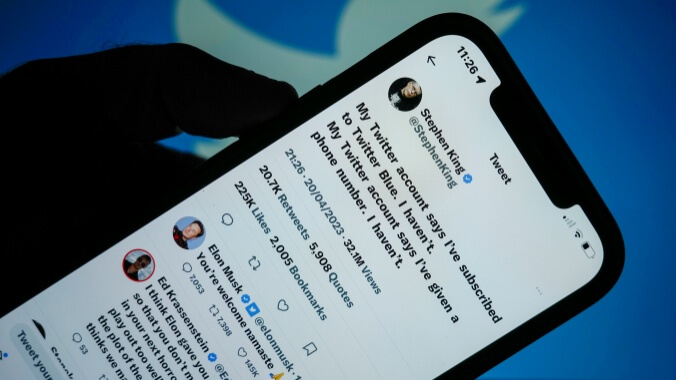Breaking Blue: The Evolving Legacy of Twitter Verification
Image via Christopher Furlong/Getty Images
For the brunt of its existence, things change came slowly for social media platform Twitter, whether it be policy changes or the details around the tried and true blue checkmark. Almost too slowly, in a lot of cases. But since Elon Musk bought and took over the service last year, the company is living up to the old adage of moving fast and breaking things. With a heavy emphasis on breaking things.
One of the most seismic and consequential changes the Musk regime has made since taking the reins of Twitter is rethinking the function of the service’s iconic blue checkmark. The blue check has been a point of pride, status, contention and confusion for more than a decade since it was created by the original Twitter team. Originally meant as a signifier that a user was “verified” as far as their identity and “notable” by often vague definition, the service was reserved largely for celebrities, journalists and brands as a way to avoid impersonation and misinformation.
But earlier this year, Musk decided to scrap it all and start (almost) fresh. Instead of representing that a user has been legitimately verified (typically through an application process and by submitting a photo ID to Twitter’s team), the blue checkmark can now be purchased for $8 per month by anyone as part of Twitter’s paid Twitter Blue service. To say it’s been a disaster would be an understatement. The rollout has been halting and messy, rife with impersonation and pranks (with some, including a checkmarked account claiming to be pharmaceutical firm Eli Lilly, briefly hitting the company’s stock price when a prankster using the company’s name claimed “insulin is free now”).
Nowadays, most blue checkmarks belong to those who have opted to pay $8 per month to sign up for Twitter Blue, including a mix of Musk fanatics, some power users, and increasingly supporters of right-wing politics and politicians (as Musk himself has become a bit of an icon among the right with his tweets and comments in recent years). Where a blue check used to mean a tweet was likely legitimate reporting or a useful comment, they’re now typically trolls, hate speech proliferators or crypto scams clogging up the top of most comment threads (because now, priority placement is given to Blue subscribers).
To make things even more confusing, Musk has since removed “legacy” verified checkmarks on almost all accounts that were verified under Twitter’s old leadership, including thousands of journalists, brands and celebrities. That rollout has also been rough, with Musk still providing some verified checkmarks for massively popular accounts with more than one million followers, which has muddied the messaging even further. He’s also launched a scheme to try and push companies into new, far more expensive, differently-colored checkmarks they can purchase for accounts and associated employees.
It can be a lot to digest, but more than anything, it’s arguably most impressive how in just a year Musk has turned an established status symbol into something frequently mocked with memes and jokes among Twitter’s former blue checkmarks (many of which are now proudly unverified).
But where did it all start? What’s the origin, and evolution, of the blue checkmark?
Twitter launched in 2006 as a plucky upstart social media and micro-blogging service that also utilized SMS messaging. It gradually became more popular over the next few years, with users flocking to the service when looking for — and sharing — immediate reactions around world events, from the Arab Spring to Super Bowl halftime shows.
-

-

-

-

-

-

-

-

-

-

-

-

-

-

-

-

-

-

-

-

-

-

-

-

-

-

-

-

-

-

-

-

-

-

-

-

-

-

-

-








































